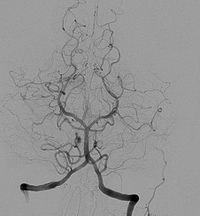
Photo from wikipedia
BACKGROUND To establish an optical coherence tomography (OCT)-based method for imaging peripheral pulmonary arteries. METHODS We recruited eight patients (five men; average age, 48±12 years; peripheral pulmonary artery thrombosis, three… Click to show full abstract
BACKGROUND To establish an optical coherence tomography (OCT)-based method for imaging peripheral pulmonary arteries. METHODS We recruited eight patients (five men; average age, 48±12 years; peripheral pulmonary artery thrombosis, three patients; idiopathic pulmonary hypertension, three patients; interstitial lung disease, two patients) who underwent OCT of the peripheral pulmonary arteries in the First Affiliated Hospital of Guangzhou Medical University and Guangzhou Institute of Respiratory Diseases, between September 2009 and September 2010. OCT was performed using both the conventional OCT imaging method (COI) and the improved pulmonary artery imaging method (IPI). In the IPI, contrast agent was used as an indicator of balloon inflation meanwhile increases in flushing speed of the replacement fluid. The percentage of optimal images, inflation pressure, flushing speeds and complications were compared between the two methods. RESULTS We performed OCT of 33 vessel segments by both methods. IPI produced more optimal images than COI (88% vs. 24%). Mean inflation pressure and flushing speed were higher during IPI than COI (0.62±0.15 vs. 0.43±0.08 atm; 1 atm =101.3 kPa; 0.82±0.10 vs. 0.42±0.06 mL/s; both P<0.01). Decreased blood oxygen saturation (SaO2) was associated with 9% and 30% segments (P<0.01) in the COI (mean decrease, 8.4%±3.6%) and IPI groups (mean decrease, 12.1%±5.3%; P<0.05) respectively. SaO2 recovered to pre-imaging levels after oxygen inhalation. CONCLUSIONS IPI is safe and effective for OCT of peripheral pulmonary arteries.
Journal Title: Journal of thoracic disease
Year Published: 2017
Link to full text (if available)
Share on Social Media: Sign Up to like & get
recommendations!